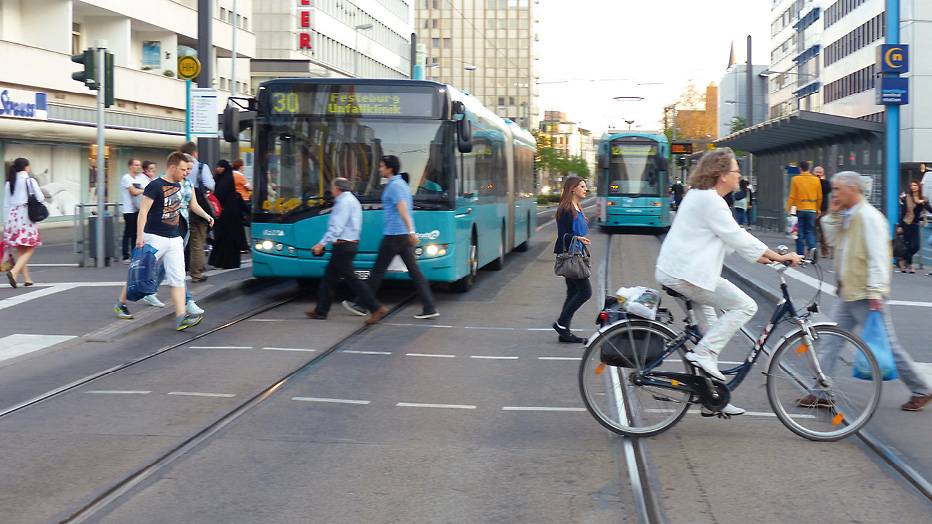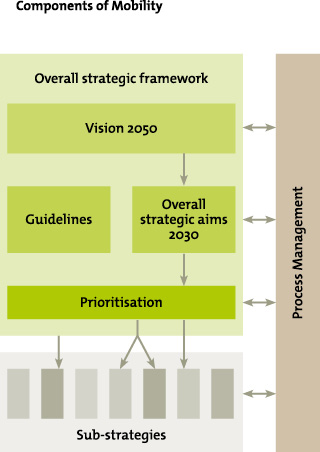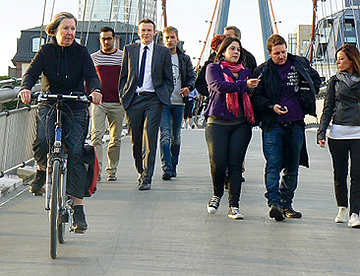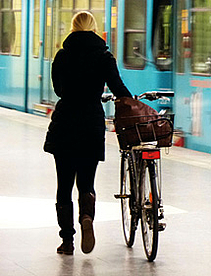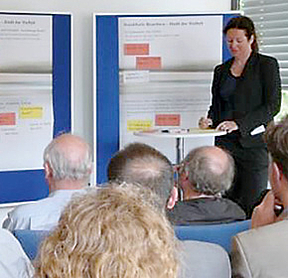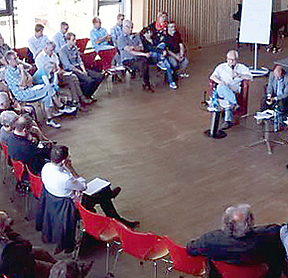Project Profile
Project Title: „Mobility Strategy“
Subject Cluster: Mobility
Project Objectives: sustainability-oriented principles of future mobility in Frankfurt, integrated planning approach and control instrument for politics and administration, strategic framework for future planning and financing decisions.
Project Launch: 2013
Project Participants: inter-departmental and interdisciplinary (Traffic, Urban and Environmental Planning)
Contact: Mobility and Traffic Planning Department
New consumption, work and lifestyle patterns, globalisation, digitalisation and demographic development – these are the societal trends which shape mobility. At the same time, the demands on mobility and quality of life in the city are changing: streets and paths should not be purely functional traffic areas but “streets for living“. The mobility strategy should be a strategic framework defining how future mobility in a growing city can be designed.
The Vision: traffic in a bustling city
The mobility strategy proposes a sustainability-oriented model, showing how a city should look in which inhabitants like to live and how they want to move in it. It is the vision of a compact, green city in which traffic affects the quality of life and human health only minimally and in which mobility in all its forms remains equally possible for everyone.
Strategic framework: orientation and measurable goals
The mobility strategy is an integral planning and control instrument which provides scope for political priorities as well as a stable framework for administrative action. It helps to react in time to future challenges and to find a consensus in the urban society on long-term aims and develop clear rules for dealing with conflicts of interest. Measurable strategic aims will monitor whether the desired or anticipated effects are achieved or if a change of course is called for.

– the proportion of the motorised private transport (MPT) in the city and region. High job density in Frankfurt equates with an employment-population ratio of 962 to 1,000. This leads to a large number of commuters whose mobility patterns influence the traffic in the city and surrounding area quite significantly.
Four components: from vision to practical activities
The mobility strategy formulates a strategic framework which forms the basis and benchmark for thematic sub-strategies and action plans. The strategic framework consists of four components – from the long-term vision to concrete courses of action: Vision 2050 describes the mobility culture envisaged and is oriented to the classic key principles of sustainability: socially equitable mobility allows everyone to take part in traffic to the greatest degree possible, taking into account differing mobility needs. Ecologically-compatible mobility coordinates traffic in an efficient, climate-friendly, sustainable manner and, as it uses regenerative raw materials, the transport system is clean and quiet. Affordable mobility options are a hallmark of economically reasonable mobility. The city’s economic performance and competitiveness benefit from Frankfurt’s good accessibility and a satisfactory configuration of all modes of transport.
Implementation guidelines serve as orientation to politics and administration on the road to realising this vision. These are based on already adopted traffic planning schemes, such as the Traffic Master Plan of 2005 and cover, for example, giving priority to the maintenance and updating of the infrastructure rather than renewing or expanding it, securing financing, promoting innovation and new technologies, using participation as an opportunity and supporting regional cooperation and sustainable mobility styles.
Over the medium-term period, until about 2030, the mobility strategy will use indicators to set measurable strategic goals which will assess whether the desired impacts have been achieved, for example whether traffic-induced CO₂ emissions or the number of traffic accidents have fallen to the desired level.
The general goals of the mobility strategy will be closely linked to extensive considerations regarding the integrated urban development concept (iStEK), e.g. promoting an integrated urban and transport structure which focuses on preventing traffic. The mobility strategy is to be incorporated as a sub-strategy into the integrated urban development concept
The guidelines and strategic aims give rise to focal points of activity which set priorities for political decisions and day-to-day administration.
Thematic sub-strategies are being developed, e.g. for urban–regional traffic, local public transport, commercial transport and road safety. The sub-strategies are often networked and, combining measures from different areas, can lead to the desired effect.
Seven guidelines for orientation
On the way to gradually moving towards the vision, which the mobility strategy outlines, seven guidelines act as orientation for politics and administration:
- The basis is the agreed General Traffic Plan (GTP)
- Advocating maintenance and upgrading of the infrastructure rather than new development and expansion
- Securing long-term funding and increasing cost transparency
- Developing and promoting innovation and new transport technologies
- Involving stakeholders / seeing participation as an opportunity
- Promoting regional cooperation
- Living a sustainable mobility culture
Participation process: how the mobility strategy takes shape
These elements of mobility strategy have been developed in interdisciplinary cooperation. The process pools the experience, competencies and strategies from several specialized fields, such as spatial urban planning and the Environment and Traffic Departments. Interim findings are discussed by the political groups in the city and local councils and consolidated in dialogue with the Sustainability Forum of the Green-City process.
Important components are communicated continuously and opened to public discussion. In 2014, two “Mobility Forums“ took place in which representatives of the urban society, an expert public and politics discussed interim results. A third “Mobility Forum“ was held in September 2015.
The first event had three key issues: “Frankfurt as the Core of the Metropolitan region“, “Frankfurt - a liveable city“ and “Frankfurt’s Districts - city of diversity“.
The second Mobility Forum discussed future mobility in Frankfurt, focussing on the three key principles of sustainability: ecologically compatible, socially-balanced and economically viable. Commuter traffic between Frankfurt and the region, intelligent solutions for delivery traffic and changes in mobility behaviour were also discussed, as was the multifunctional use of the limited urban space.
Parallel to the first two Mobility Forums, ideas on future mobility were collected and discussed on the city’s participation portal “Frankfurt fragt mich“. The findings were included in the work on the mobility strategy.
The third Mobility Forum presented the current status of the mobility strategy. At the same time, working groups studied in depth the focal points of activity which had been formulated and also discussed new financing options for the public transport network and more environmentally-friendly delivery traffic management.
The aim of this process is to develop a mobility strategy agreed upon by the city parliament and which involves all the local stakeholders. The mobility strategy is not, however, a “completed work“. It must be reviewed and updated regularly so it can serve as a framework for future planning- and financing decisions.

Vision
Compact, green city; streets for living; traffic hardly affects quality of life or human health; -mobility remains equally possible for everyone.

Strategic framework
Providing scope for political priorities and a stable framework for administrative action; reacting in time to future challenges; setting measurable strategic goals.

